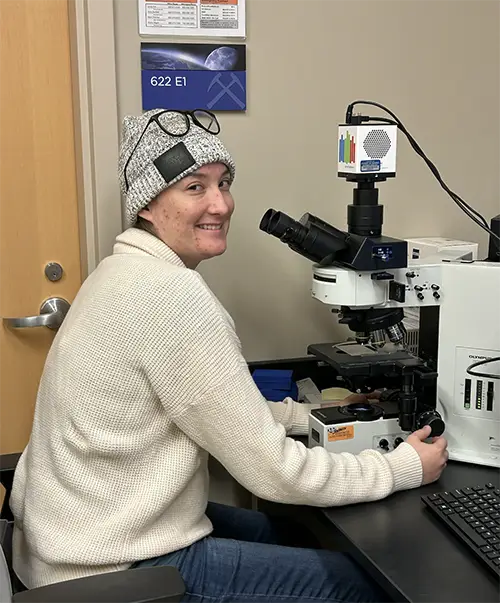Diagenesis Paths Shown in Microfossil-bearing Chert
Diagenesis Paths Shown in Microfossil-bearing Chert

In early diagenetic chert we commonly find detailed preservation of the cellular structures of microbes that made up our earliest ecosystems. However, that fossil preservation is subject to modification over thousands—to billions—of years of post-depositional fluid flow.
Kaitlyn Gauvey is a fourth year PhD student who is exploring the pathways of diagenesis in microfossil-bearing, early diagenetic chert with her advisor, Linda Kah, the EEPS Kenneth R. Walker Professor. Earlier in the Kah Lab, Jeremy Dunham (MS ’18) and Ashley Manning-Berg (PhD ’18) noted that microfossiliferous chert of the 1.1 billion-year-old Angmaat Formation, Northern Baffin Island, preserved a through-going rectilinear microfabric when examined under polarized light. The rectilinear fabric was hypothesized to result from the three-dimensional stacking of 20-50 micron chalcedony spherules.
This rectilinear fabric was so prevalent in the Angmaat Formation that Gauvey started asking whether the fabric was common in microfossil-bearing cherts. She requested and received samples from Professor Emeritus Andrew Knoll at Harvard University—the foremost authority on Precambrian microfossils—that spanned both time and space. With the samples, Gauvey showed, first, that this rectilinear petrographic fabric is common to all microfossil-bearing cherts. She began, however, to also note that the preservation of the individual spherules varied.
Gauvey has since deciphered several distinct pathways of diagenesis, wherein chalcedony spherules (which consist of a three-dimensional array of micro-scale fibrous crystals) undergo various patterns of grain coarsening that incorporates similarly oriented fibers into single, larger crystals. The degree to which this grain coarsening occurs appears to reflect whether silica is permeating an originally organic or mineral matrix, as well as the degree of water-rock interaction.
Gauvey also has been exploring different techniques (XRD, SEM-EBSD, Raman spectroscopy, and FTIR spectroscopy) to further explore microfossiliferous cherts, and she has submitted her first manuscript on these fabrics.